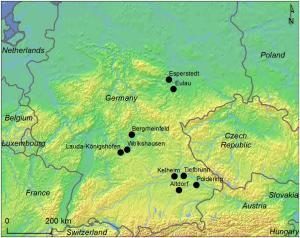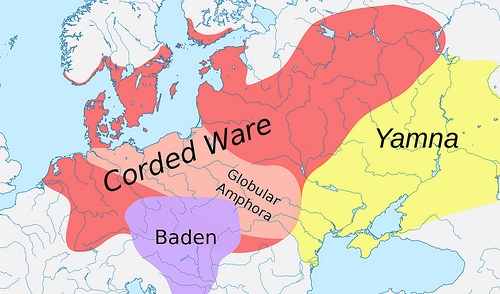
PLOS—Women in the Corded Ware Culture may have been highly mobile and may have married outside their social group, according to a study* published May 25, 2016 in the open-access journal PLOS ONE by Karl-Göran Sjögren from Göteborg University, Sweden, and colleagues.
The Corded Ware Culture is archaeologically defined by material traits, such as the burial of the dead under barrows alongside characteristic cord-ornamented pottery, and existed in much of Europe from ca. 2800-2200 cal. B.C. To better understand this culture, the authors of the present study examined human bones and teeth from seven sites in Southern Germany dating from different periods of Corded Ware culture, including two large cemeteries. They used carbon dating and additional dietary isotope analysis to assess the diet and mobility of the population during this period.
_________________________________________
Location of sampled sites and other Corded Ware sites. Credit: Map by K-G Sjögren, using public domain data.
__________________________________________
The Corded Ware culture (also Battle-axe culture) is an enormous Chalcolithic and Early Bronze Age archaeological grouping, flourishing ca. 3200 – 2300 BC. It encompasses most of continental northern Europe from the Rhine River on the west, to the Volga River in the east, including most of modern-day Germany, Denmark, Poland, the Baltic States, Belarus, the Czech Republic, Slovakia, northern Ukraine, and western Russia, as well as southern Sweden and Finland. It receives its name from the characteristic pottery of the era; wet clay was decoratively incised with cordage, i.e., string. It is known mostly from its burials. Note that this map does not reproduce the information accurately; it loses the depiction of culture areas as overlapping, and the indication of the core territory of Yamna. “Globular amphora” is to be understood as a predecessor and/or subgroup of Corded Ware and not as a distinct “neighboring” culture. Text and image: Wikimedia Commons
_______________________________________________________
Examples of Corded Ware Culture pottery. Einsamer Schütze, Wikimedia Commons
_________________________________________
The researchers found great dietary variation both between and within sites, indicating that the people of the Corded Ware culture subsisted in a variety of ways. Like humans in earlier cultures, they consumed both animal and plant matter. However, it is likely that at least some sites practiced more intense dairy and arable farming than in previous periods. Around 42% of individuals buried in one of the large cemetery sites were found to be non-local, with many females likely to have originated from elsewhere. This result may indicate that women across generations in this culture were very mobile.
The authors suggest that their evidence of varied diet and mobility supports the possibility of a stable system of female exogamy, where women married outside of their social group and moved to their husbands’ settlements, in Corded Ware Culture.
Karl-Göran Sjögren notes: “Our results suggest that Corded Ware groups in southern Germany were highly mobile, especially the women. We interpret this as indicating a pattern of female exogamy, involving different groups with differing economic strategies, and suggesting a complex pattern of social exchange and economic diversity in Late Neolithic Europe.”
Source: Edited from the subject PLOS news release.
______________________________________________________
______________________________________________________

______________________________________________
Travel and learn with Far Horizons.
____________________________________________
This richly illustrated issue includes the following stories: Recent findings shedding new light on the whereabouts of the remains of Philip of Macedon, father of Alexander the Great; how an archaeologist-sculptor is bringing bones of the dead back to life; archaeologists uncovering town life at the dawn of civilization; an exclusive interview with internationally acclaimed archaeologist James M. Adovasio about what makes the Meadowcroft Rockshelter prominent in the ongoing search for the first Americans; what archaeologists are finding at the site of the ancient city of Gath, the home town of the biblical Philistine giant, Goliath; and how scientists are redrawing the picture of human evolution in Europe. Find it on Amazon.com.










